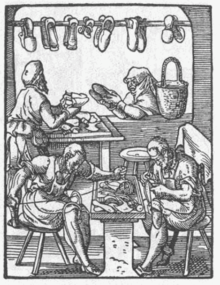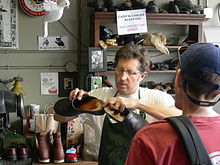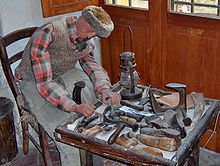- Shoemaking
-
"Shoemaker" redirects here. For other uses, see Shoemaker (disambiguation).
 Woodcut of shoemakers from 1568
Woodcut of shoemakers from 1568 A shoemaker at the Roscheider Hof Open Air Museum
A shoemaker at the Roscheider Hof Open Air Museum
Shoemaking is the process of making footwear. Originally, shoes were made one at a time by hand. Traditional handicraft shoemaking has now been largely superseded in volume of shoes produced by industrial mass production of footwear, but not necessarily in quality, attention to detail, or craftsmanship.
Shoemakers or cordwainers (cobblers being, historically, those who repair shoes) may produce a range of footwear items, including shoes, boots, sandals, clogs and moccasins. Such items are generally made of leather, wood, rubber, plastic, jute or other plant material, and often consist of multiple parts for better durability of the sole, stitched to a leather upper.
Contents
Traditional shoemaking
Most shoemakers use a last—made traditionally of iron or wood, but now often of plastic— on which to form the shoe. Some lasts are straight, while curved lasts come in pairs: one for left shoes, the other for right shoes.
Traditional shoemakers used to use more than 15 different techniques of making shoes. Some of these are: pegged construction, English Welted (machine-made versions are referred to as "Goodyear Welted" after the inventor of the technique), goyser welted, Norwegian, stitchdown, turnout, German sewn, moccasin, bolognese stitched, and blake-stitched.
Some types of ancient and traditionally-made shoes include:
- Furs wrapped around feet, and sandals wrapped over them: used by Romans fighting in northern Europe.
- Clogs: wooden shoes, often filled with straw to warm the feet.
- Moccasins: simple shoes, often without the durability of joined shoes (although different types of leather have different wear characteristics).
In modern times
Current crafters, in developing regions or supply constrained areas may use used or surplus car or truck tire tread sections as an inexpensive and plentiful material resource to make strong shoe soles or sandals with.
The Society for Creative Anachronism offers some advice about making period shoes for people engaged in the leisure activity of historical reenactment.
In popular culture
The shoemaking profession makes a number of appearances in popular culture, such as in stories about shoemaker's elves, and the proverb "The shoemaker's children go barefoot"[1]. The patron saint of shoemakers is Saint Crispin.
Chefs and cooks sometimes use the term "shoemaker" as an insult to others who have prepared sub-standard food, possibly by overcooking, implying that the chef in question has made his or her food as tough as shoe leather or hard leather shoe soles, and thus may be in the wrong profession. Similarly, to "cobble" can mean not only to make or mend shoes, but "to put together clumsily; to bungle."[2]
Famous shoemakers
Rabbi Yochanan Hasandlar, a famous sage of the Third Century AD, might have earned his living as a sandal maker, though the nickname might also indicate that he was a native of Alexandria.[3]
Pope Urban IV, born Jacques Pantaléon, was the son of a cobbler of Troyes, France.
Eva Shoemaker, a modern shoemaker, made her living by bartering with nearby colleagues. She tendered to the Notre Dame community in Los Angeles.
See also
- Cobbler
- Cordwainer
- Order of the Knights of St. Crispin, an American labor union of 50,000 shoemakers c. 1870
- Sandler
- Shoe repair shop
References
- ^ "Proverb Quotes". http://thinkexist.com/quotation/the_shoemakers_children_go/159047.html.
- ^ The Free Dictionary http://www.thefreedictionary.com/cobble
- ^ "Avoth, Chapter Four, Mishnah Eleven - Reading for Wednesday, September 22, 2003". Mishnahyomit Archives. http://uscj.org/scripts/wa.exe?A2=ind0310&L=mishnahyomit&D=0&P=2816. Retrieved 20 October 2010.
External links
Categories:- Shoemaking
- Shoes
- Footwear
- Crafts
- Artisans
Wikimedia Foundation. 2010.


